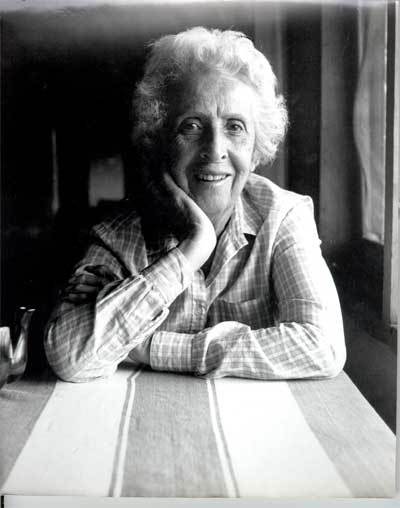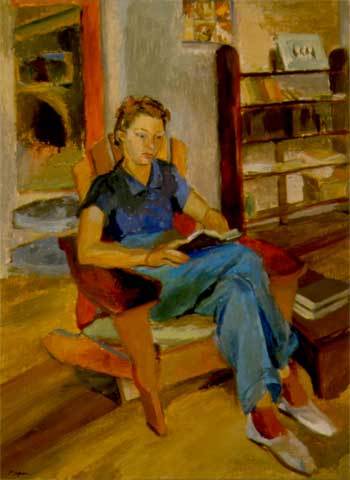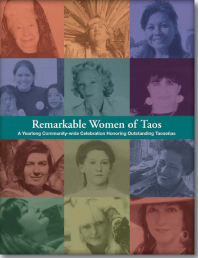Margaret Lefranc
MARGARET LEFRANC (SCHOONOVER) 1907-1998
Father owned ships… mother rode horses at our summer home….Our library had portraits of famous people, Rosa Bonheur’s Horse Fair print and a stained glass window…These influenced me to paint…My sister bought me some plasticene when I was six. I made a bas relief of an Indian head. From then on all I ever wanted to be was an artist.”
 Margaret received the New Mexico Governor’s Award for Excellence in the Arts (1996). “I’m a color expressionist with classical training and tried everything in order to grow…Drawing is a must for serious artists.”
Margaret received the New Mexico Governor’s Award for Excellence in the Arts (1996). “I’m a color expressionist with classical training and tried everything in order to grow…Drawing is a must for serious artists.”
At thirteen Margaret studied at the Art Students League before accompanying her parents to Berlin where she contracted rheumatic fever. Confined to bed, Lefranc used charcoal to draw starving men and women who posed by her bedside. She studied at the Kunstschule des Westens and a year later in Paris with Andrew L’Hote, the Sorbonne, Academie des Grand Chaumier, and Basil Tchoukaieff. “They taught me how to look at art differently. Cézanne’s art influenced me greatly.” Lefranc’s exhibitions from 1927 – 1930 drew rave reviews at age twenty-one at the Salon d’Automne and Salon des Tuileries. Once returning home to renew a passport at eighteen, she met Alfred Stieglitz who looked at her art, “Young lady, you’re very gifted, but you’re very French…Come back when you’ve lived in America for ten years.”
Permanently in the United States in 1933, Lefranc exhibited at New York World’s Fair, Corcoran Gallery, Pennsylvania Academy, Philbrook, Oklahoma Art Center, the Harwood, Museum of New Mexico, Lowe, Cline and others.
To see the land of her birth, in 1939 Margaret drove from New York to Taos—welcomed by Frieda Lawrence—and inadvertently met W. H. Auden, written for El Palacio and Pasatiempo during the 1990s. “Taos was still of the Old Colony of Mable Dodge Luhan, Oscar Berninghous, Nicolai Fechin…Still a small Spanish village bathed in the massive almost palpable silence flowing from the nearby Pueblo.” Later, Margaret and Nicolai Fechin would go sketching together, upon his trips from California to visit his daughter, Eya, a dancer, and her then husband Dane Rudhyar, an astrologer and philosopher. They were neighbors of Margaret’s in Nambe. They, along with Alice Marriott, anthropologist, would discuss philosophy for hours over lunch at Doc Martin’s at the Historic Taos Inn and attended exhibitions at the Harwood in Taos. Of course Rudhyar insisted upon doing Margaret’s chart.
 Margaret vowed to Frieda that after she’d saved a thousand dollars, she would move to Taos. “Frieda was…a woman of Amazon vigor and proportion…and was a comfortable German hausfrau. Her peasant blouse and full ankle-length skirt added to this impression embellished by the New World touches of concha belt and Taos moccasins…Frieda bustled about the kitchen preparing our lunches which she served with pride, pointing out that she always made her own bread and churned the butter." In 1945 Lefranc left Cooper Union and her rambunctious husband and ran to Taos.
Margaret vowed to Frieda that after she’d saved a thousand dollars, she would move to Taos. “Frieda was…a woman of Amazon vigor and proportion…and was a comfortable German hausfrau. Her peasant blouse and full ankle-length skirt added to this impression embellished by the New World touches of concha belt and Taos moccasins…Frieda bustled about the kitchen preparing our lunches which she served with pride, pointing out that she always made her own bread and churned the butter." In 1945 Lefranc left Cooper Union and her rambunctious husband and ran to Taos.
The closest place to live near Taos during war time was a three-room-box-car type adobe house with no heat, no water, and no electricity—in Nambe, a life experience which Margaret illustrated for Alice Marriot in The Valley Below. A noted painter, illustrator and editor, in 1948 she received a “Fifty Best Books of the Year” award from the Library of Congress in conjunction with the American Institute of Graphic Arts for her illustrations of San Ildefonso native pottery in Maria: The Potter of San Ildefonso and in 1952 for Indians of the Four Corners. Eventually she was adopted by the Pueblo Indians and became trusted friends of Maria Martinez, Laura Gilpin, Georgia O’Keeffe and others. “Georgia didn’t know much about cats…trying to shoo Mommy off furniture. Georgia was having people over and had just arranged a lovely big bowl of salad and placed it on the table…set for everyone to arrive…Mommy jumped on the table…and used the salad bowl as a litter box…Mommy was banished to my house…Some months later a car roared up to my kitchen door and out came Maria Chabot with two gunnysacks. She was breathless, ‘Alfred Stieglitz has died…O’Keeffe has left for New York. I’ve closed her home and am going there to help.’ Chabot put one huge sack on the floor with food. The other sack had…another cat… Anselmo…and Chabot raced away. Anselmo loved classical music…and stationed himself on top of the radio every Sunday at two o’clock…and waited. What a perfect cat for O’Keeffe.” Ten years later Margaret self-built her home in Santa Fe.
Lefranc worked in a variety of media (oil, watercolor, gouache, pastel, etching, monotype and charcoal), and the portraits and landscapes that she created in a range of styles reflect cubist and other avant-garde influences. Before her life-changing trip to Taos, Margaret closed her Guild Art Gallery in New York. (Papers are stored in the Archives of American Art, Smithsonian.) She gave Arshile Gorky his first one man drawing exhibition in New York. Exhibitions followed for Chaim Gross, Yasuo Kuniyoshi and almost any other painter or sculptor working in New York.
Born in Brooklyn, New York, March 15, 1907, Lefranc died in Santa Fe, New Mexico, on September 5, 1998.
The Margaret Lefranc Art Foundation was formed 1994, Santa Fe. Sandra McKenzie, President, preserves Lefranc’s legacy and Lefranc’s works of art through books and exhibitions: 100th Birthday Exhibition, Gerald Peters Gallery, Santa Fe; and traveling shows from Virginia to Utah, An American Original: Fifty Years of Watercolors. Both Rutgers University’s WAAND database and the University of Central Oklahoma Oral History Department document Lefranc’s life as do Women Artists of the American West, various Who’s Who, the Margaret Lefranc website, a vertical file stored at the National Museum of Women in the Arts, D.C., and a publication and a film, A Lifetime of Imaging: The Art of Margaret Lefranc.
Two traveling exhibitions and catalogues define the heart of Margaret: Breaking Boundaries by the U.S. State Department’s Art and the Embassies program (1999 – 2001), Paris, and Independent Spirits (1995), Gene Autry Western Heritage Museum.
by Sandra McKenzie, President
Margaret Lefranc Art Foundation
www.margaretlefranc.org
McKenzieHi@aol.com
A Lifetime of Imaging: The Art of Margaret Lefranc: Film and Book
"1996 Governor's Award for Excellence and Achievement in the Arts, Painting, NM"








